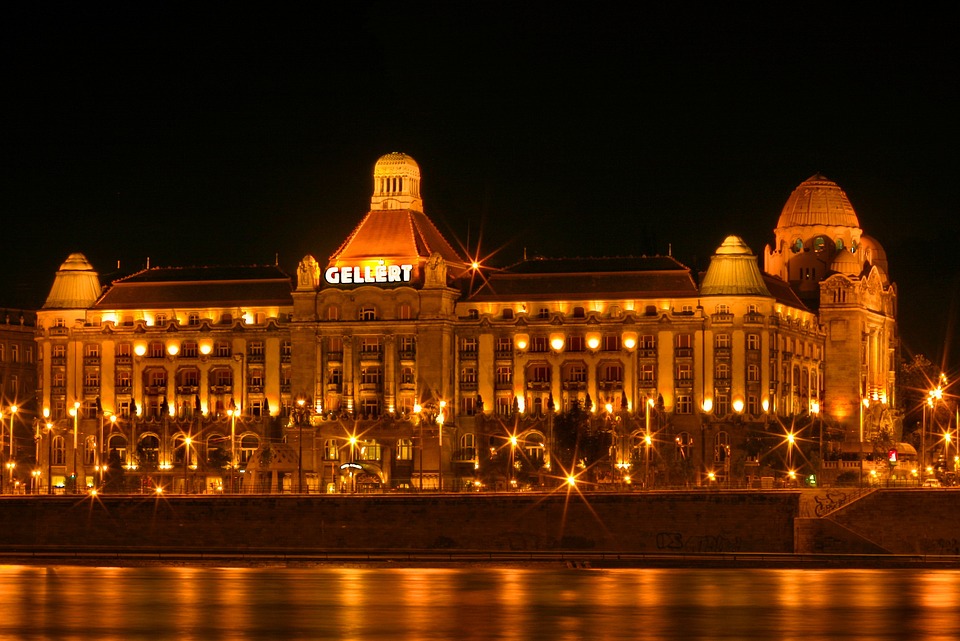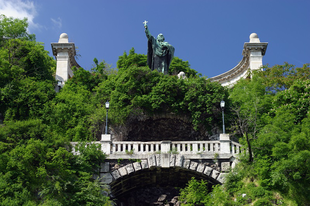
Rising on the Buda-side bank of the Danube between Szabadság-híd (Liberty Bridge) and Erzsébet-híd (Elizabeth Bridge) the 235-m-high Gellérthegy (Gellert Hill) is a nature protection area in teh city. Gellért-hegy, this craggy dolomite hill is one area you’d be foolish to miss: it offers a fabulous view of the city and is as much a feature of Budapest’s waterfront panorama as Várhegy and the Parliament building. Gellért Hill offers some of the best panoramic views of Budapest.

The first recorded names of this area in the Middle Ages were Kelen-hegy, Pesti-hegy and Blocksberg. The former name, Pesti-hegy (Mons Pestiensis in Latin) referred to the large cave in the hillside - the word is of Slavic origin and means oven or cave. It was called Szent Gellért hegye (lit. the hill of St. Gerard) from the 15th century onwards, referring to the legend about the death of st. Gerard.
St. Gerard was born in a Venetian noble family, and his parents soon sent him to the monastery, offering him to spiritual life. Gerard left for a pilgrimage to the Holy Land, but a storm forced him to seek refuge in a Benedictine monastery on an island near Istria. He came in Hungary and King Stephen I convinced Gerard to serve God here, to convert Hungarians to Christianity and to build a Christian Church promising that he would authorize Gerard to preach anywhere in Hungary. Stephen I died on 15 August 1038 and the saintly bishop was was killed by the pagans during the great pagan rebellion in 1046.
What do you see in Budapest near Gellert Hill? At the foot of the hill, the graceful wrought-iron Szabadság híd (Liberty Bridge) links the inner boulevard of Pest to Szent Gellért tér on the Buda side, dominated by the Art Nouveau Gellért Hotel. Liberty Bridge was Budapest's third permanent bridge. Originally called the Ferenc József híd (Franz Joseph Bridge and it was opened during the 1896 millennium celebrations of the founding of Hungary.

The Gellért Hotel (bult in the beginning of the 1900s) is famous for its beautiful thermal baths and summer terrace. Here you can enjoy the benefits of the healing waters in the recently renovated pools of the spa.
„During the 1930s and 1940s, the hotel’s balls were the highlight of Budapest’s social calendar, when debutantes danced on a glass floor laid over its pool. The ostentatious domed drinking fountain in front of the hotel has been the source of some controversy: symbolizing the eight springs of Budapest, it was erected without planning permission, and the city authorities toyed with the idea of pulling it down before relenting” wrotes The Rough Guide to Budapest.

On the hillside opposite the Gellért Hotel you’ll find the Sziklatemplom (Cave Church or Church by the Rock). In these caves members of the Hungarian-founded order, the monks of Saint Paul lived in Medieval times. The church was founded in 1926, by a group of Pauline monks after a pilgrimage to Lourdes, France. Originally, the altar was located at the entrance of the cave and the congregation was seated outdoors on the terrace. This is why Cave Church is called Church by the Rock in Hungarian. Expansion of the cave and structural reinforcement followed throughout the 1930s. The monastery was also built around this time. During World War II, the church served as a hospital and asylum. The entrance of the curch was was walled after the World War II, during the communist dictatorship and was reopened in 1991.
In 1904 a monument was erected at the site where Gellért or Gerard met his death. I love so much the bronze statue of Szent Gellért or St. Gerard looking out over the Elizabeth Bridge! The statue of the bishop, designed by sculptor Gyula Jankovits, is framed by a neoclassical semi-circular colonnade and below the sculpture sits a pretty man-made waterfall.

The Citadella (Citadel) on the top of Gellert Hill was built in 1854 by the Habsburgs after the crushing of the 1848-49 Hungarian Revolution and War of Independence based on the plans of Emmanuel Zitta, an Austrian military engineer. The fortificaion wasnever fully completed and at present there is an exhibition of military history in the courtyard.
The Statue of Liberty, clearly visible from most parts of Budapest was erected outside the Citadel in 1947. The well-known symbol of the city was made by sculptor Zsigmond Kisfaludy Stróbl, the 14-m-tall female figure holds up an olive branch as a sign of peace and freedom.

North of Gellért-hegy, the Tabán, once Buda’s artisan quarter, now has more roads than buildings and makes an incongruous setting for one of Budapest’s most historic and magical Turkish baths, the Rudas. Rudas is probably the most popular and most atmospheric medieval Turkish bath in Budapest, built by Sokoli Mustafa, Pasha of Buda between 1566 and 1578 near some springs currently known as Attila, Hungaria and Juventus. This building is amazing combination of old and new. Did you know that Rudas baths were used as a location for the opening scene of the 1988 movie Red Heat starring Arnold Schwarzenegger and James Belushi?






